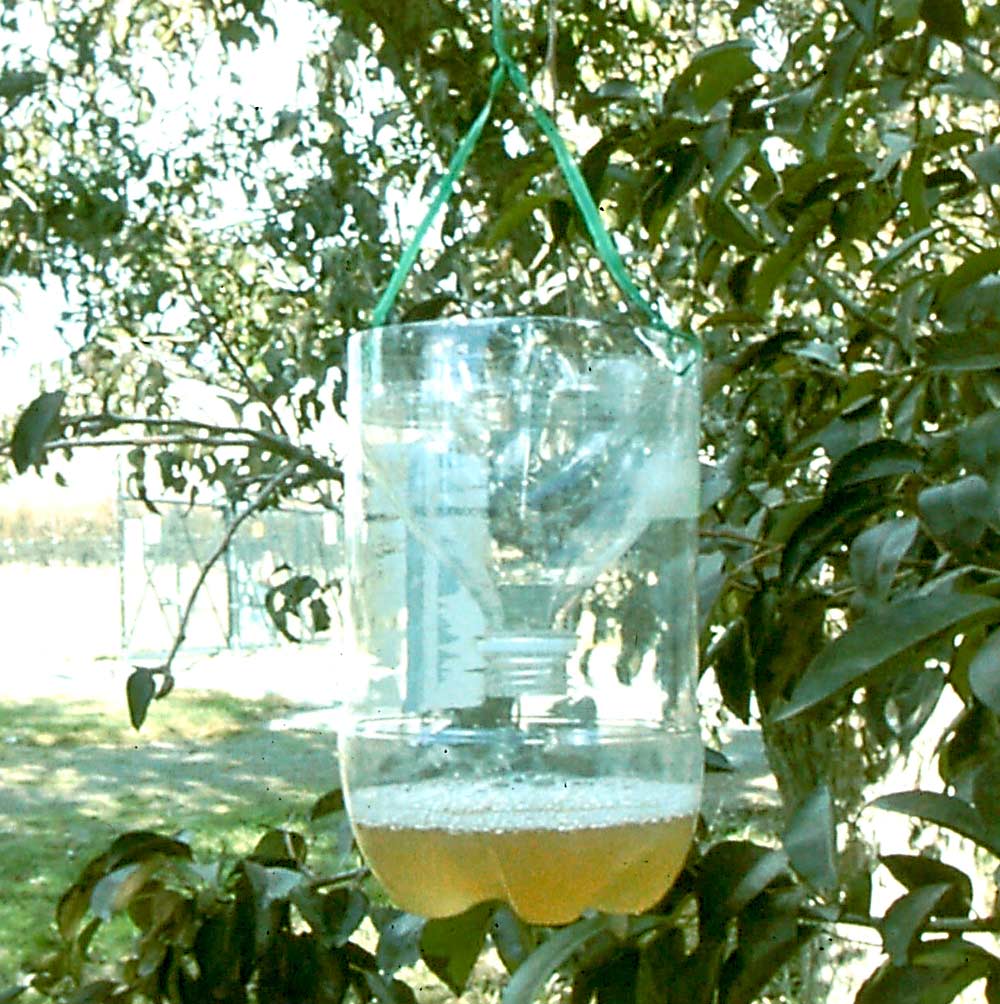
A lack of commercially available lures that attract wasps with the promise of food makes building your own wasp trap a popular option for many growers.
A knowledge of the chemical ecology of pests is beneficial when trying to develop an effective trap, Dr. Peter Landolt of the U.S. Department of Agriculture in Yakima, Washington, told growers attending the annual B.C. Wine Grape Council viticulture conference in Penticton, British Columbia, Canada, this past summer.
The cornerstones of that ecology are pheromones and kairomones, chemicals that regulate the signals insects give each other and other species. Pheromones are the same-species regulators, governing the signals associated with sexual behavior and other phenomena. Kairomones regulate signals between different species, and figure in plant defenses against insects. Toying with those natural chemistries in order to tell insects to stay away from developing fruit or to control pest populations (as in the case of codling moth) is one of the challenges before entomologists, Landolt said.
“We’ve got aspects of their behavior that is affected or mediated by chemicals, and our goal is to try and trick them into doing something to our advantage,” he said.
When it comes to the European paper wasp and other social wasps, knowing what the insects’ chemistries are can help growers control wasp populations to make harvest safer and less angst-ridden for workers.
The chief problems associated with the wasps include workers not wanting to go into the vineyard to pick infested fruit; complaints of wasps biting the skin of good fruit; and also complaints that the presence of wasps contributes to microbial infection and the spread of fungus and mold.
Sugar
Social wasps prey on insects, carrion, and sugars. It is the sugar that draws them to damaged fruit. Just seven types of social wasps are pests, with the five major species in the Pacific Northwest including Vespula pennsylvanica and V. germanica, Polistes aurifer and P. dominulus, and Dolichovespula maculata.
“They’re stinging, and they’re predatory, generally, even though you might not think so if they’re munching on grapes,” Landolt said to the British Columbia grape growers. “You may not feel this way, but you’re extremely fortunate in having a very small subset of problems with insects that attack grapes compared to the rest of North America. I hope it stays that way.”
Since there’s next to nothing in the scientific literature regarding social wasps and grapes, many growers have opted for do-it-yourself solutions when it comes to traps. The key, however, is determining what kind of wasp problem exists and using that information to determine the best response.
Traps
Growers can devise two types of traps, depending on the insects they’re dealing with.
Western yellow jackets will be drawn to meat baits, while sweet baits will attract other wasps.
A simple meat-baited trap will feature a hunk of meat—fresh fish is ideal—hung over soapy water. The angle of the rig suspending the meat should be obtuse, Landolt said, as the wasps will try to carve off as large a piece of meat as possible. The goal is to have them knock themselves into the soapy water while they’re trying to fly away with the hunk of meat.
Sweet baits include fruit juices and other liquids.
Landolt described a simple trap growers could make by cutting off the top of a soda bottle, inverting the top, and placing it back in the body of the bottle such that wasps fly into the trap through the mouth of the bottle (which points toward a juice solution in the base of the bottle) but can’t escape back out.
The key to attracting wasps to the bait is getting the chemistry right. Since the wasps are usually attracted to decaying fruit, the juice solution will have to be fermenting enough to have started releasing aromas attractive to the wasps. Since heavy sugar solutions don’t grow microbes very well, Landolt recommends loading the trap with a mixture with a 1:10 ratio of juice to water. Accelerating the ferment with a piece of fruit that’s started to break down wouldn’t hurt, either. “It takes time to kick in,” Landolt said. “Don’t be disappointed if on the first day you don’t get much.”
Wasps have excellent three-dimensional mapping capabilities, however, so traps should exploit what Landolt described as their “positive chemotaxis,” “negative geotaxis,”and “positive phototaxis”—in plain language, the fact that wasps will be attracted to the fermenting juice, and will tend to fly upwards towards light after feeding.
Design and placement
Some of the best-designed traps therefore feature an entrance at the base, Landolt said, with a clear top and opaque walls. This makes the traps easy for wasps to enter but difficult to exit. Adding a teaspoon of liquid detergent to the bait mix will make it difficult for the insects to fly, further compounding their problems.
While some traps use heat to quickly knock down wasps that enter the traps, Landolt advised growers to avoid lacing sweet baits with pesticides. These attract honeybees and may inadvertently lead to the destruction of entire bee colonies.
Since ripe and damaged grapes will compete with traps for the wasps’ attention, Landolt advised growers to trap preemptively, with a view to getting rid of wasps before they become a problem.
Positioning traps every ten meters (33 feet) around the perimeter of the vineyard as well as within a vineyard would be helpful.
And, while most growers will probably just want to get rid of the insects, Landolt urged growers to bring in a sample of what they’ve found. The sample may help identify what’s in the vineyard. Since the wasps doing the most damage to the grapes will be on the grapes themselves, growers should focus on gathering these insects whenever possible.

Leave A Comment